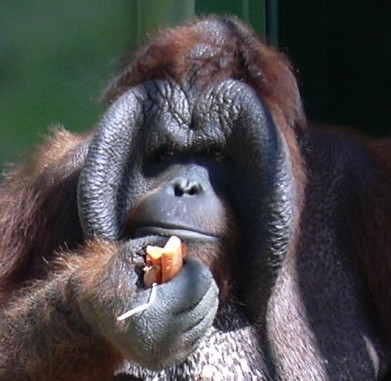Adaptation
Orangutans possess many adaptations that help them live successfully in their habitat. Orangutans spend almost all of their day in the tree canopy so it is no surprise that they have adapted to live in the trees. The arm length of an Orangutan is 7 feet which allows them to hang on to branches and support themselves. Although Orangutans are considered brachiators, they are very cautious climbers and use any combination of their four grasping extremities (1). The term Brachiator is used loosely with Orangutans since they never jump or drop from tree limb to limb (5). Orangutans suspend their weight from their arms and tree sway using trees like a pole vault. Besides the length of their arms, Orangutans possess a more fully opposable big toe and a highly mobile hip. This adaptation is a consequence of their primary Arboreal lifestyle. In contrast, Gorillas and Chimpanzees live a primary Terrestrial lifestyle.
Orangutans are the only Great Ape to travel predominantly through the trees. When Orangutans do come out of the trees and travel on the ground, they use a method of walking called "Fist Walking". This method of walking Quadrupedally is done by curling the thumb around their fist and as the name implies, walking on their fists. The other Great Apes (Gorillas, Chimpanzees, and Bonobos) travel terrestrially by walking quadrupedally on their knuckles, a method known as "Knuckle Walking".
| The adult male Orangutan possess cheek pads and a drooping laryngeal throat pouch. These characteristics are not only intimidating to other Orangutans, but they also help the male Orangutan with his long call. Male Orangutans give off "long calls" that will notify other Orangutans of the male's location in the forest and keep other competing males from approaching the area (2).The cheek pads of adult males are believed to increase the distance of their long call and the massive size creates a convincing threat to their challengers. These pads are made up of subcutaneous collections of fibrous tissue between the eyes and ears. |
 |
Another adaptation shown by Orangutans is the replacement of sharp claws by flattened nails. Biologists believe that this adaptation led to the development of highly sensitive tactile pads on the phalanges (1). Orangutans can also use separate power & precision grips, and possess separate control of all their fingers. Additionally, In captivity Orangutans have been observed manufacturing and using tools, acquiring basic language skills such as sign language, and solving problems using insight and reasoning (5). Recently, Orangutans living in the wild have been seen using sticks to extract termites from trees and use large leaves as umbrellas when it is raining heavily.
